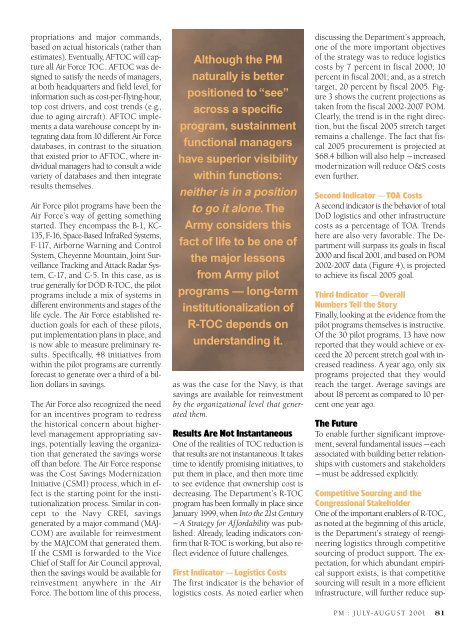Reducing Total Ownership Cost in DoD - Defense Acquisition ...
Reducing Total Ownership Cost in DoD - Defense Acquisition ...
Reducing Total Ownership Cost in DoD - Defense Acquisition ...
You also want an ePaper? Increase the reach of your titles
YUMPU automatically turns print PDFs into web optimized ePapers that Google loves.
propriations and major commands,based on actual historicals (rather thanestimates). Eventually, AFTOC will captureall Air Force TOC. AFTOC was designedto satisfy the needs of managers,at both headquarters and field level, for<strong>in</strong>formation such as cost-per-fly<strong>in</strong>g-hour,top cost drivers, and cost trends (e.g.,due to ag<strong>in</strong>g aircraft). AFTOC implementsa data warehouse concept by <strong>in</strong>tegrat<strong>in</strong>gdata from 10 different Air Forcedatabases, <strong>in</strong> contrast to the situationthat existed prior to AFTOC, where <strong>in</strong>dividualmanagers had to consult a widevariety of databases and then <strong>in</strong>tegrateresults themselves.Air Force pilot programs have been theAir Force’s way of gett<strong>in</strong>g someth<strong>in</strong>gstarted. They encompass the B-1, KC-135, F-16, Space-Based InfraRed Systems,F-117, Airborne Warn<strong>in</strong>g and ControlSystem, Cheyenne Mounta<strong>in</strong>, Jo<strong>in</strong>t SurveillanceTrack<strong>in</strong>g and Attack Radar System,C-17, and C-5. In this case, as istrue generally for DOD R-TOC, the pilotprograms <strong>in</strong>clude a mix of systems <strong>in</strong>different environments and stages of thelife cycle. The Air Force established reductiongoals for each of these pilots,put implementation plans <strong>in</strong> place, andis now able to measure prelim<strong>in</strong>ary results.Specifically, 48 <strong>in</strong>itiatives fromwith<strong>in</strong> the pilot programs are currentlyforecast to generate over a third of a billiondollars <strong>in</strong> sav<strong>in</strong>gs.The Air Force also recognized the needfor an <strong>in</strong>centives program to redressthe historical concern about higherlevelmanagement appropriat<strong>in</strong>g sav<strong>in</strong>gs,potentially leav<strong>in</strong>g the organizationthat generated the sav<strong>in</strong>gs worseoff than before. The Air Force responsewas the <strong>Cost</strong> Sav<strong>in</strong>gs ModernizationInitiative (CSMI) process, which <strong>in</strong> effectis the start<strong>in</strong>g po<strong>in</strong>t for the <strong>in</strong>stitutionalizationprocess. Similar <strong>in</strong> conceptto the Navy CREI, sav<strong>in</strong>gsgenerated by a major command (MAJ-COM) are available for re<strong>in</strong>vestmentby the MAJCOM that generated them.If the CSMI is forwarded to the ViceChief of Staff for Air Council approval,then the sav<strong>in</strong>gs would be available forre<strong>in</strong>vestment anywhere <strong>in</strong> the AirForce. The bottom l<strong>in</strong>e of this process,Although the PMnaturally is betterpositioned to “see”across a specificprogram, susta<strong>in</strong>mentfunctional managershave superior visibilitywith<strong>in</strong> functions:neither is <strong>in</strong> a positionto go it alone.TheArmy considers thisfact of life to be one ofthe major lessonsfrom Army pilotprograms — long-term<strong>in</strong>stitutionalization ofR-TOC depends onunderstand<strong>in</strong>g it.as was the case for the Navy, is thatsav<strong>in</strong>gs are available for re<strong>in</strong>vestmentby the organizational level that generatedthem.Results Are Not InstantaneousOne of the realities of TOC reduction isthat results are not <strong>in</strong>stantaneous. It takestime to identify promis<strong>in</strong>g <strong>in</strong>itiatives, toput them <strong>in</strong> place, and then more timeto see evidence that ownership cost isdecreas<strong>in</strong>g. The Department’s R-TOCprogram has been formally <strong>in</strong> place s<strong>in</strong>ceJanuary 1999, when Into the 21st Century— A Strategy for Affordability was published.Already, lead<strong>in</strong>g <strong>in</strong>dicators confirmthat R-TOC is work<strong>in</strong>g, but also reflectevidence of future challenges.First Indicator — Logistics <strong>Cost</strong>sThe first <strong>in</strong>dicator is the behavior oflogistics costs. As noted earlier whendiscuss<strong>in</strong>g the Department’s approach,one of the more important objectivesof the strategy was to reduce logisticscosts by 7 percent <strong>in</strong> fiscal 2000; 10percent <strong>in</strong> fiscal 2001; and, as a stretchtarget, 20 percent by fiscal 2005. Figure3 shows the current projections astaken from the fiscal 2002-2007 POM.Clearly, the trend is <strong>in</strong> the right direction,but the fiscal 2005 stretch targetrema<strong>in</strong>s a challenge. The fact that fiscal2005 procurement is projected at$68.4 billion will also help — <strong>in</strong>creasedmodernization will reduce O&S costseven further.Second Indicator — TOA <strong>Cost</strong>sA second <strong>in</strong>dicator is the behavior of total<strong>DoD</strong> logistics and other <strong>in</strong>frastructurecosts as a percentage of TOA. Trendshere are also very favorable. The Departmentwill surpass its goals <strong>in</strong> fiscal2000 and fiscal 2001, and based on POM2002-2007 data (Figure 4), is projectedto achieve its fiscal 2005 goal.Third Indicator — OverallNumbers Tell the StoryF<strong>in</strong>ally, look<strong>in</strong>g at the evidence from thepilot programs themselves is <strong>in</strong>structive.Of the 30 pilot programs, 13 have nowreported that they would achieve or exceedthe 20 percent stretch goal with <strong>in</strong>creasedread<strong>in</strong>ess. A year ago, only sixprograms projected that they wouldreach the target. Average sav<strong>in</strong>gs areabout 18 percent as compared to 10 percentone year ago.The FutureTo enable further significant improvement,several fundamental issues — eachassociated with build<strong>in</strong>g better relationshipswith customers and stakeholders— must be addressed explicitly.Competitive Sourc<strong>in</strong>g and theCongressional StakeholderOne of the important enablers of R-TOC,as noted at the beg<strong>in</strong>n<strong>in</strong>g of this article,is the Department’s strategy of reeng<strong>in</strong>eer<strong>in</strong>glogistics through competitivesourc<strong>in</strong>g of product support. The expectation,for which abundant empiricalsupport exists, is that competitivesourc<strong>in</strong>g will result <strong>in</strong> a more efficient<strong>in</strong>frastructure, will further reduce sup-PM : JULY-AUGUST 2001 81
















